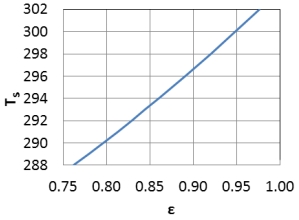
The Earth/atmosphere system as viewed from space must be in radiative equilibrium. The system receives radiation
from the sun:
( 1) SoπR2
where So is the extraterrestrial constant (about 1360 W/m2) and R is the
radius of the Earth/atmosphere system. The Earth/atmosphere system has a reflectivity (planetary albedo)
of α = 0.29, so it reflects
about 29% of the incoming radiation and absorbs the rest. The absorbed radiation must be
balanced by thermal radiation from the Earth/atmosphere system according to the Stefan-Boltzmann law.
Assuming the Earth/atmosphere system behaves like a perfect spherical blackbody radiator with an emissivity of 1 at Te:
( 2) πR2•So(1 – α) = 4πR2•σTe4
Simplifying:
( 3) (So/4)(1 – α) = σTe4
Solve for the effestive radiating temperature of the Earth/atmosphere system as observed from space Te:
( 4) Te = [(340•0.71)/5.67 x 10-8) = 255.4 K ≈ –18°C
But, fortunately for life as we understand it, the average temperature at Earth's surface is about 15-16°C, a temperature
which will support liquid water. The difference of
about 34°C is a result of the greenhouse effect.
A useful extension of the radiative
balance for the Earth/atmosphere system as viewed from space assumes a single-layer
atmosphere at constant temperature (an isotropic atmosphere). The surface and atmosphere have different temperatures
and presumably the effective temperature defined in ( 4) lies somewhere between these two values. Asssume that
the atmosphere does not interact at all with incident and reflected (shortwave) solar radiation, but
that it absorbs and re-radiates thermal radiation, equally downward and upward, acting like an imperfect blackbody with
an emissivity ε less than 1. With this assumption, the Earth/atmosphere system albedo is the same as the
average albedo of Earth's surface, including its average cloud cover; it is though clouds were "painted" onto Earth's surface
rather than being part of and interacting with the atmosphere. This is not a bad assumption for a system in radiative balance.
At the top of the atmosphere the infrared flux F from the atmosphere to space is the flux emitted by the atmosphere
itself at temperature Ta and the flux from Earth's surface at temperature Ts
that escapes through the atmosphere:
( 5) F↑ = εσTa4 + (1 – ε)σTs4
As viewed from space, this process still requires that the system be in radiative balance with the incoming
radiation:
( 6) (So/4)(1 – α) = εσTa4 + (1 – ε)σTs4
Energy balance at Earth's surface requires that the total incoming radiation, solar plus infrared flux emitted downward
from the atmosphere, equals the outgoing thermal radiation:
( 7) (So/4)(1 – α) + εσTa4 = σTs4
Eliminate (So/4)(1 – α) using (6) and (7):
( 8) εσTa4 + (1 – ε)σTs4 =
σTs4 – εσTa4
Solve for Ta:
( 9) Ta = Ts/21/4 = 0.841•Ts

|
| Figure 1. Surface temperature as a function of atmospheric emissivity. |
| The single-layer isotropic atmosphere greenhouse model is summarized in Figure 2. The percentages are percentages of incoming solar radiation.
The radiation incident on
Earth's surface — a combination
of absorbed incoming solar radiation and thermal radiation from the atmosphere — is balanced by thermal radiation leaving the surface.
Radiation leaving the top of the atmosphere — a combination of reflected incoming solar radiation,
thermal radiation from Earth's surface passing through the atmosphere, and thermal radiation from the atmosphere — is equal to the total
incoming solar radiation.
For a system in equilibrium, the incoming and outgoing radiation must continue to balance both at Earth's surface and the top of the atmosphere. How the balance is achieved depends on the planetary albedo, which can be changed by changing average cloudiness, for example, and the emissivity of the atmosphere, which can be changed by changing concentrations of greenhouse gases (including water vapor). Changing these values will change temperatures at the surface and in the atmosphere. Temperatures can also be changed by changing the extraterrestrial constant. This simple model "decouples" Earth's surface and its atmosphere, which is not true in the real world in which solar/atmosphere/surface processes are interconnected in multiple and complex ways. But, it provides a conceptual starting point for thinking about interactions between surface and atmosphere and the physical processes that might modify both the planetary albedo (including the effects of cloud cover) and the behavior of the atmosphere. Ultimately, the "big questions" of climate lie with determining how natural processes and anthropogenic activities modify albedo and atmospheric emissivity. |
| |||